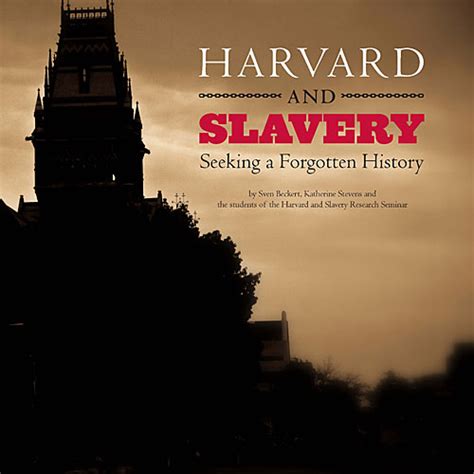
Harvard University hired a researcher to investigate the institution’s historical ties to slavery, but that research ultimately led to her dismissal, the researcher alleges.
Dr. Evelynn M. Hammonds, a distinguished Harvard professor and scholar of the history of science, technology, and race, claims her contract was not renewed after she began uncovering uncomfortable truths about the university’s extensive connections to the slave trade and the profits it generated. Hammonds, who is also the former Dean of Harvard College, argues that the university’s commitment to transparency and reconciliation is being undermined by its reluctance to fully confront its past. Harvard denies the allegations, asserting that the decision not to renew her contract was based on programmatic needs and budgetary constraints.
Hammonds was initially brought on board to contribute to Harvard’s “Legacy of Slavery” initiative, a highly publicized effort to examine and address the university’s historical entanglement with slavery. This initiative was launched in response to growing calls for accountability from students, faculty, and alumni, and followed similar acknowledgments and reparative efforts by other universities, such as Brown and Georgetown. The initiative involved extensive archival research, public forums, and the creation of educational resources aimed at fostering a deeper understanding of slavery’s impact on Harvard and the broader society.
According to Hammonds, her research quickly revealed that Harvard’s involvement in slavery was far more pervasive and profitable than previously acknowledged. She says that her findings detailed not only the university’s direct ownership of enslaved people but also the significant financial benefits it derived from investments in slave-based industries, donations from slaveholders, and the intellectual justification of slavery advanced by some of its prominent faculty members.
“What I discovered was a deeply entrenched system of exploitation and profit that permeated every aspect of Harvard’s operations,” Hammonds stated in an interview. “From the endowment to the curriculum, slavery was integral to the university’s growth and prosperity.”
Hammonds alleges that as her research delved deeper into these uncomfortable truths, she began to experience resistance from certain members of the university administration. She claims that her access to certain archives was restricted, and that her research findings were met with skepticism and attempts to downplay their significance. Ultimately, she says, her contract was not renewed, effectively ending her involvement in the “Legacy of Slavery” initiative.
“I believe that my dismissal was a direct result of my research uncovering information that the university was not prepared to confront,” Hammonds asserted. “They wanted a superficial investigation that would appease critics without truly challenging the institution’s power and privilege.”
Harvard University has vehemently denied Hammonds’ allegations. In a statement, a university spokesperson stated that the decision not to renew her contract was based solely on programmatic needs and budgetary considerations. The spokesperson emphasized that Harvard remains fully committed to the “Legacy of Slavery” initiative and that the university is dedicated to transparency and reconciliation.
“Harvard University is unwavering in its commitment to understanding and addressing its historical connections to slavery,” the statement read. “The decision regarding Dr. Hammonds’ contract was made independently of her research and was based on the evolving needs of the program and the university’s financial situation.”
However, Hammonds’ supporters argue that her dismissal raises serious questions about Harvard’s true intentions regarding the “Legacy of Slavery” initiative. They contend that the university’s actions send a chilling message to other researchers and scholars who might be hesitant to challenge powerful institutions.
“This is a clear case of silencing a scholar who was doing important work,” said Professor Henry Louis Gates Jr., a prominent Harvard historian and a leading voice in the effort to address the university’s ties to slavery. “Dr. Hammonds’ research was essential to understanding the full extent of Harvard’s complicity in slavery, and her dismissal is a setback for the cause of truth and reconciliation.”
The controversy surrounding Hammonds’ dismissal has sparked widespread debate on campus and beyond. Students and faculty members have organized protests and petitions calling for greater transparency and accountability from the university. They argue that Harvard must fully confront its past in order to build a more just and equitable future.
The case also highlights the challenges and complexities of addressing historical injustices in the context of powerful institutions. Universities, corporations, and governments are increasingly being called upon to acknowledge and atone for their past wrongdoings, but the process is often fraught with controversy and resistance.
“This is not just about Harvard,” said Professor Annette Gordon-Reed, a Pulitzer Prize-winning historian and expert on slavery. “It’s about the broader issue of how we as a society grapple with the legacy of slavery and the ongoing struggle for racial justice.”
The situation surrounding Dr. Hammonds’ departure raises critical questions about academic freedom, institutional accountability, and the sincerity of efforts to address historical injustices. It also underscores the need for a more comprehensive and transparent approach to researching and acknowledging the role of slavery in shaping American institutions. The ongoing debate is likely to continue as Harvard and other universities grapple with their complex and often uncomfortable pasts.
Detailed Analysis of Harvard’s “Legacy of Slavery” Initiative
Harvard University’s “Legacy of Slavery” initiative represents a significant step in acknowledging and addressing the institution’s historical ties to slavery. Launched in response to mounting pressure from students, faculty, and alumni, the initiative aims to uncover the full extent of Harvard’s involvement in slavery and its lasting impact on the university and society. The initiative includes several key components:
-
Extensive Archival Research: This involves a thorough examination of Harvard’s archives to identify documents, records, and artifacts that shed light on the university’s connections to slavery. This includes tracing the ownership of enslaved people by Harvard faculty and staff, identifying investments in slave-based industries, and analyzing the intellectual justifications for slavery advanced by Harvard scholars.
-
Public Forums and Discussions: The initiative organizes public forums and discussions to engage the Harvard community and the broader public in conversations about slavery, race, and justice. These events provide a platform for scholars, activists, and community members to share their perspectives and experiences.
-
Educational Resources: The initiative develops educational resources, such as websites, exhibitions, and curricula, to educate students, faculty, and the public about Harvard’s history of slavery and its ongoing legacy. These resources are designed to promote a deeper understanding of the complex and often uncomfortable truths about the university’s past.
-
Reparative Efforts: While the full extent of Harvard’s reparative efforts is still evolving, the university has committed to supporting initiatives that promote racial justice and equity. This includes funding scholarships for descendants of enslaved people, investing in programs that address racial disparities in education and healthcare, and partnering with community organizations that are working to dismantle systemic racism.
The “Legacy of Slavery” initiative is led by a committee of scholars, administrators, and community members who are responsible for overseeing the research, programming, and outreach efforts. The committee is chaired by Professor Tomiko Brown-Nagin, Dean of the Radcliffe Institute for Advanced Study and a leading scholar of constitutional law and history.
Despite the university’s stated commitment to transparency and reconciliation, the initiative has faced challenges and criticisms. Some critics argue that the university’s efforts are too limited in scope and that they do not go far enough in addressing the lasting harms of slavery. Others contend that the university is not being fully transparent about its findings and that it is attempting to control the narrative surrounding its history of slavery.
The controversy surrounding Dr. Hammonds’ dismissal has further fueled these criticisms and raised serious questions about the university’s true intentions. Her supporters argue that her dismissal demonstrates that Harvard is not truly committed to confronting its past and that it is more interested in protecting its reputation than in promoting truth and reconciliation.
The Broader Context: Universities and the Legacy of Slavery
Harvard University is not alone in grappling with its historical ties to slavery. In recent years, a growing number of universities across the United States have launched similar initiatives to examine and address their connections to slavery. This trend reflects a broader reckoning with the legacy of slavery in American society and a growing recognition of the need for institutions to acknowledge and atone for their past wrongdoings.
Some of the universities that have undertaken significant efforts to address their ties to slavery include:
-
Brown University: In 2003, Brown University established a Steering Committee on Slavery and Justice to investigate the university’s historical connections to slavery and the transatlantic slave trade. The committee’s report, published in 2006, detailed the significant financial benefits that Brown derived from slavery and the slave trade, and it recommended a series of reparative actions, including the establishment of a center for the study of slavery and justice.
-
Georgetown University: In 2016, Georgetown University apologized for its historical sale of 272 enslaved people in 1838 to save the university from financial ruin. The university has since taken steps to atone for its past, including offering preferential admission to descendants of the enslaved people and renaming buildings to honor their memory.
-
The University of Virginia: The University of Virginia has launched several initiatives to examine and address its historical connections to slavery, including the creation of a Memorial to Enslaved Laborers on its campus. The university has also established a research center dedicated to the study of slavery and its legacies.
These initiatives represent important steps in acknowledging and addressing the historical injustices of slavery. However, they also highlight the challenges and complexities of this work. Universities must navigate a range of ethical, legal, and political considerations as they grapple with their pasts. They must also engage in open and honest dialogue with their communities and be willing to confront uncomfortable truths.
The Ethical and Legal Considerations
Addressing historical injustices such as slavery raises a number of complex ethical and legal considerations. One key issue is the question of reparations. Should universities and other institutions that benefited from slavery be required to provide financial or other forms of compensation to descendants of enslaved people?
The legal basis for reparations is complex and contested. Some legal scholars argue that there is a strong legal case for reparations based on theories of unjust enrichment and restitution. They contend that institutions that profited from slavery should be required to return those profits to the victims of slavery or their descendants.
Other legal scholars argue that there are significant legal obstacles to reparations, including the difficulty of establishing a direct causal link between slavery and present-day harms, the statute of limitations, and the lack of legal standing for descendants of enslaved people.
Despite these legal challenges, the movement for reparations is gaining momentum. In recent years, several cities and states have established commissions to study the feasibility of reparations. Some universities have also begun to explore the possibility of providing reparations in the form of scholarships, grants, and other forms of support.
In addition to the legal considerations, there are also important ethical considerations to consider. Some argue that reparations are a moral imperative, regardless of the legal obstacles. They contend that institutions that benefited from slavery have a moral obligation to atone for their past wrongdoings and to help address the ongoing harms of slavery.
Others argue that reparations are not the best way to address the legacy of slavery. They contend that reparations could be divisive and that they might not be effective in addressing the root causes of racial inequality. They suggest that other approaches, such as investing in education, healthcare, and economic development, might be more effective in promoting racial justice.
The Role of Academic Freedom
The controversy surrounding Dr. Hammonds’ dismissal raises important questions about academic freedom. Academic freedom is the principle that scholars should be free to pursue their research and teaching without fear of censorship or reprisal. It is a cornerstone of academic inquiry and a vital safeguard against political interference in the pursuit of knowledge.
In the context of researching historical injustices, academic freedom is particularly important. Scholars who are investigating sensitive or controversial topics may face pressure from institutions, governments, or other powerful actors to suppress their findings or to alter their conclusions. Academic freedom protects scholars from such interference and ensures that they are free to pursue the truth, wherever it may lead.
However, academic freedom is not absolute. It is subject to certain limitations, such as the obligation to conduct research ethically and to respect the rights of others. It is also subject to the legitimate needs of institutions to manage their resources and to ensure the quality of their programs.
The question of whether Dr. Hammonds’ academic freedom was violated is a complex one. On the one hand, she was hired to conduct research on Harvard’s ties to slavery, and she alleges that her contract was not renewed because of the findings she uncovered. If this is true, it could be argued that her academic freedom was violated.
On the other hand, Harvard argues that the decision not to renew her contract was based on programmatic needs and budgetary considerations. If this is true, it could be argued that the decision was a legitimate exercise of the university’s managerial prerogative.
The controversy highlights the challenges of balancing academic freedom with the legitimate needs of institutions. It also underscores the importance of transparency and accountability in decision-making processes that affect academic freedom.
The Future of the “Legacy of Slavery” Initiative
The controversy surrounding Dr. Hammonds’ dismissal has cast a shadow over Harvard’s “Legacy of Slavery” initiative. It remains to be seen whether the university will be able to regain the trust of its community and to continue its efforts to address its historical ties to slavery in a transparent and meaningful way.
To move forward, Harvard must take several steps:
-
Conduct an independent investigation into Dr. Hammonds’ dismissal: This investigation should be conducted by an impartial third party and should be transparent and accountable. The findings of the investigation should be made public.
-
Reaffirm its commitment to academic freedom: Harvard must clearly reaffirm its commitment to academic freedom and ensure that scholars are free to pursue their research without fear of censorship or reprisal.
-
Strengthen the “Legacy of Slavery” initiative: Harvard should strengthen the “Legacy of Slavery” initiative by providing it with more resources and by ensuring that it is led by scholars who are committed to truth and reconciliation.
-
Engage in open and honest dialogue with the community: Harvard must engage in open and honest dialogue with its community about its history of slavery and its ongoing legacy. This dialogue should involve students, faculty, staff, alumni, and community members.
By taking these steps, Harvard can demonstrate its commitment to transparency, accountability, and reconciliation and can ensure that the “Legacy of Slavery” initiative fulfills its promise of promoting a deeper understanding of the university’s past and its ongoing impact on society.
Frequently Asked Questions (FAQs)
-
Why did Harvard launch the “Legacy of Slavery” initiative?
- The initiative was launched in response to growing calls from students, faculty, and alumni for Harvard to acknowledge and address its historical ties to slavery. These calls were part of a broader national movement to confront the legacy of slavery in American institutions.
-
What are the main goals of the “Legacy of Slavery” initiative?
- The goals include uncovering the full extent of Harvard’s involvement in slavery, educating the community about this history, fostering dialogue on race and justice, and supporting reparative efforts to address the ongoing harms of slavery.
-
What does Dr. Hammonds allege about her dismissal?
- Dr. Hammonds alleges that her contract was not renewed because her research uncovered uncomfortable truths about Harvard’s extensive connections to the slave trade and the profits it generated. She claims that her findings were met with resistance from the university administration.
-
What is Harvard’s response to Dr. Hammonds’ allegations?
- Harvard denies the allegations, stating that the decision not to renew her contract was based on programmatic needs and budgetary considerations, independent of her research. They maintain their commitment to the “Legacy of Slavery” initiative.
-
What are the implications of this controversy for other universities addressing their ties to slavery?
- The controversy raises concerns about academic freedom and institutional accountability. It highlights the challenges universities face when confronting uncomfortable truths about their past and the potential for resistance from within the institution. It also underscores the need for transparency and independent oversight in these initiatives to ensure their credibility and effectiveness.









